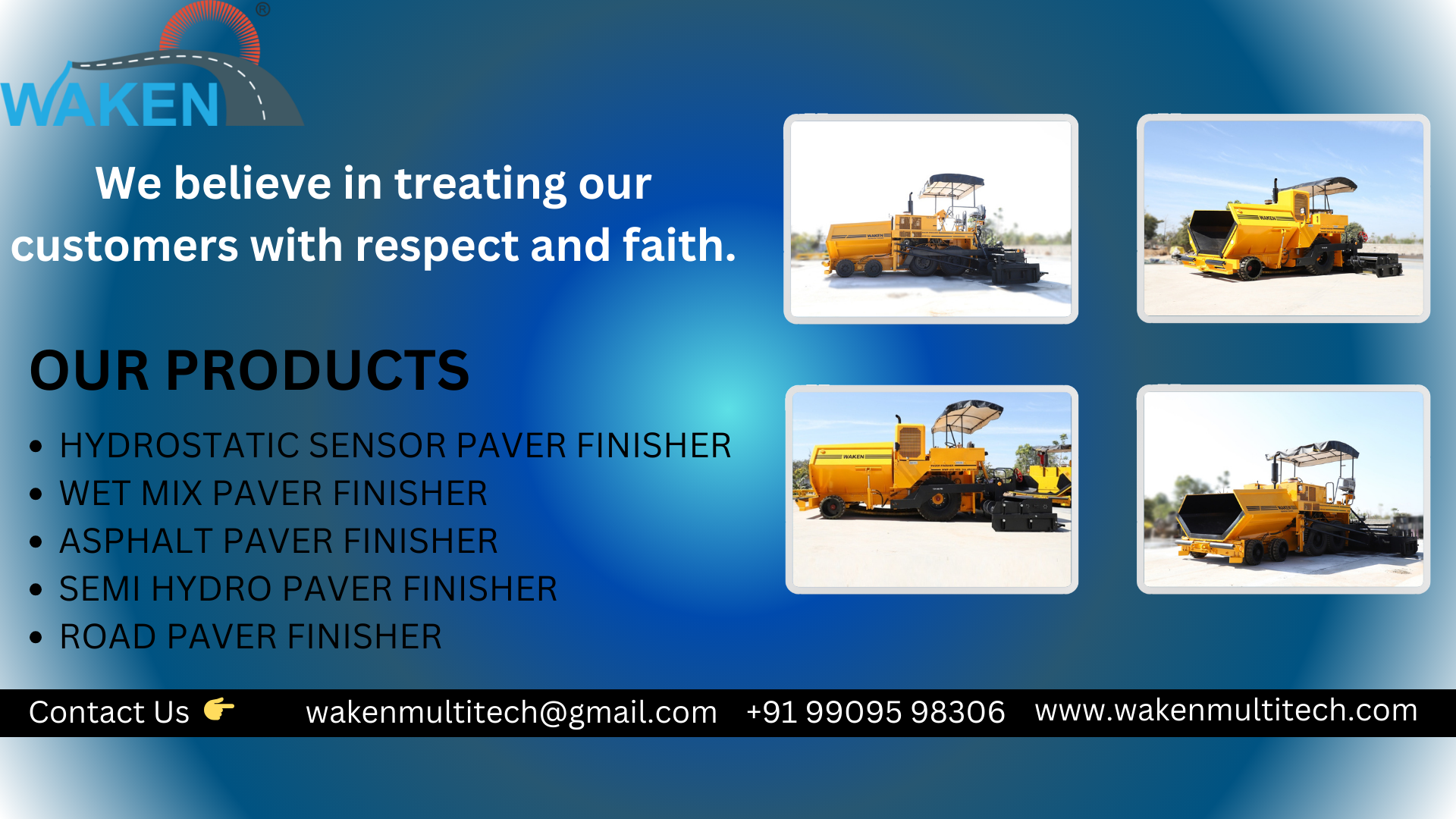
Hydrostatic Sensor Paver Finisher: An In-Depth Overview
Hydrostatic Sensor Paver Finisher: An In-Depth Overview
Introduction
A Hydrostatic Sensor Paver Finisher is an advanced road construction machine used for laying asphalt (bituminous materials) on roads, bridges, and highways. Unlike conventional mechanical pavers, hydrostatic sensor pavers operate using a hydrostatic transmission system and sensor-based leveling controls, offering higher precision, efficiency, and automation. India has emerged as a significant manufacturer and exporter of these machines due to its booming infrastructure development and engineering capabilities.
What is a Hydrostatic Sensor Paver Finisher?
A Hydrostatic Sensor Paver Finisher is a machine that lays the asphalt mix evenly and provides initial compaction before rolling. It uses a hydrostatic drive system for smooth and variable-speed operations, while sensors help maintain accurate mat thickness and smooth surface levels.
How It's Made (Manufacturing Process)
Manufacturing a hydrostatic sensor paver involves several critical stages:
-
Design & Engineering:
-
CAD modeling and simulations ensure proper material flow, weight distribution, and operator ergonomics.
-
-
Material Selection:
Abrasion-resistant materials for augers and conveyors
-
Fabrication:
-
Welding and machining of the main chassis, hoppers, screed plates, and conveyor housing.
-
Laser cutting for precision fit parts.
-
-
Assembly:
-
Mounting the engine (diesel-powered)
Assembling electrical and sensor systems
-
-
Installation of Sensors:
-
Grade sensors, slope sensors, and ultrasonic sensors for automatic leveling
-
-
Quality Testing:
-
Road simulation tests for speed control, screed temperature, and paving accuracy.
-
-
Painting & Finishing:
Final Inspection & Dispatch:
-
Trial run conducted before delivery.
-
Where It’s Used
Hydrostatic Sensor Paver Finishers are used in:
-
National and State Highways
-
Airport Runways
-
Urban Roads and Streets
-
Bridge Decks
-
Industrial Roads (Ports, SEZs, Logistics Parks)
Key Features
-
Hydrostatic Transmission: Smooth and variable movement of machine parts
-
Sensor-Based Control: Laser, ultrasonic, or mechanical sensors for grade and slope accuracy
-
High Precision Screed: Electrically or hydraulically heated for uniform compaction
-
Hopper Feed System: For consistent flow of asphalt mix
-
Operator Platform: Ergonomic design with full visibility
-
Electric/Mechanical Vibrators: Ensures uniform laying
-
Automation Interface: Digital dashboard and sensor calibration interface
Importance in Infrastructure Development
-
Ensures Road Longevity: Accurate leveling reduces early surface failures.
-
Speeds Up Construction: High output capacity meets project deadlines.
-
Reduces Manual Intervention: Less dependency on operator skill.
-
Meets International Standards: Suitable for FIDIC and NHAI projects.
Advantages
| Feature | Advantage |
|---|---|
| Hydrostatic Drive | |
| Sensor Technology | Consistent mat thickness and smoothness |
| Fuel Efficient Engines | Reduces operating cost |
| High Maneuverability | Ideal for curves, city roads, and tight spots |
| Precision Screed Heating | Reduces cold joints and improves finish |
| Automated Leveling | Minimizes human error |
| Low Maintenance Design | Fewer moving parts in hydrostatic systems |
Significance in the Indian Context
-
‘Make in India’ Push: Boosts local manufacturing and exports.
-
Customized for Indian Conditions: Handles dusty environments, variable road base, and high ambient temperatures.
-
Used in PMGSY and Smart City Projects: Essential for rural and urban road modernization.
Why Choose Indian Manufacturers?
-
Cost-Effective: Lower cost than imported European or Japanese models.
-
After-Sales Service Network: Faster support and parts availability.
-
Adaptability: Machines tailored to Indian specifications and climate.
-
Innovation: Indian OEMs now integrate IoT-based diagnostics and GPS.
FAQs
Q1: What is the life expectancy of a hydrostatic sensor paver?
A well-maintained machine can last 10–15 years or more, depending on usage and terrain.
Q2: How accurate are the sensors in these machines?
Sensors can maintain ±2 mm accuracy, depending on calibration and surface conditions.
Q3: Do these machines work in hilly areas?
Yes, with the proper setup, they are capable of operating on inclines with controlled slope sensors.
Q4: How much area can it cover in a day?
Depending on the model, it can pave up to 6,000–10,000 sq.m per day under optimal conditions.
Q5: Can the screed be extended?
Yes, many models have telescopic screeds that can extend up to 4.5–6 meters or more.
Conclusion
Hydrostatic Sensor Paver Finishers are a critical asset in the road construction industry, especially in a rapidly developing nation like India. These machines combine hydraulic efficiency, sensor-driven precision, and automation to deliver world-class road surfaces. Indian manufacturers are increasingly making a mark with quality, affordability, and serviceability, making them a smart choice for contractors and infrastructure companies both domestically and internationally.
Contact-+91 99095 98306 , +91 99092 66948 , +91 9033840168
Gmail:-wakenmultitech@gmail.com
Website:-https://wakenmultitech.com/
Our Blogs
- Asphalt Paver Finisher
- Asphalt Paver Finisher
- Top Wet Mix Paver Finisher Manufacturer in India
- Wet Mix Paver Finisher
- Wet Mix Paver Finisher Manufacturer in India
- Wet Mix Paver Finisher Manufacturer in Gujarat
- Wet Mix Paver Finisher Manufacturer
- Wet Mix Paver Finisher
- Wet Mix Paver Finisher
- Wet Mix Paver Finisher
- Wet Mix Paver Finisher
- Hydrostatic Sensor Paver Finisher: An In-Depth Overview
- Hydrostatic Sensor Paver Finisher Manufacturer
- Hydrostatic Sensor Paver Finisher Manufacturer
- Hydrostatic Sensor Paver Finisher Manufacturer
- Hydrostatic Sensor Paver Finisher in Gujarat
- Hydrostatic Sensor Paver Finisher Price in India
- Sensor Paver Manufacturer
- Wheeled Paver Finisher
- Highway Road Paver Finisher
- Paver Machines with Hydraulically Extendable Screed
- Mechanical Paver Finisher WM 6 HES
- Automatic Sensor Paver Finisher
- Mechanical Pavers Finishers
- Paver Finisher Machine
- Paver Machine
- Mechanical Paver
- Road Paver Machine
- 4.5 Meter Automatic Sensor Paver
- Semi Sensor Paver Finisher